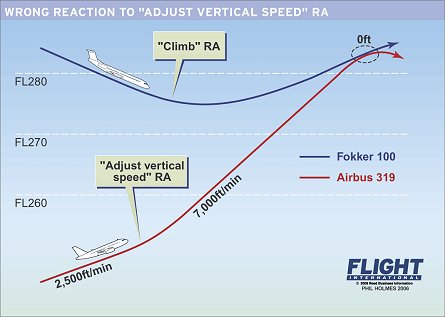DAVID LEARMOUNT / LONDON
Eurocontrol forced to reissue guidance on correct responses to anti-collision alerts
Eurocontrol has reissued advice to pilots on how to react to airborne collision avoidance system (ACAS) resolution advisories (RA) following a series of recent events in which crews have failed to follow procedures correctly and avoided disaster only through luck.
A frequent erroneous pilot response to an ACAS alert is incorrect reaction to the “adjust vertical speed” RA, triggered when aircraft are converging vertically at a high rate, says Eurocontrol. It cites an example of a near-collision that occurred because the pilot of an Airbus A319, climbing to flight level 260 (26,000ft/7,925m), reacted to an “adjust vertical speed” RA by increasing his rate of climb dramatically and maintaining it through his cleared flight level until the two aircraft passed each other with no vertical separation, but with 2.4km (1.3nm) lateral separation (see graphic).
|
The other aircraft, a Fokker 100, had been cleared to descend to FL270, but the pilot reacted correctly to a “climb” RA. Eurocontrol says that the correct reaction to an “adjust vertical speed” RA is always to reduce climb or descent rate – never to increase it – and although the frequency of this error is being reduced by improved ACAS training, conflicts are still occurring.
In an event evoking the 1 July 2002 fatal collision over Uberlingen, southern Germany, Eurocontrol describes how the pilot of a Boeing 767 converging with an A319 disregarded his ACAS “descend” RA and instead followed an air traffic control (ATC) instruction to climb, while the A319 pilot followed his “climb” RA. The aircraft missed each other vertically by 400ft (120m) and horizontally by 0.5km, says Eurocontrol. The conflict had arisen because the two aircraft, originally on converging headings but separated by 2,000ft vertically (the 767 at FL290 and A319 at FL270), were under the control of different ATC units in charge of lower and upper airspace, with a boundary between the two sectors at 28,500ft.
The A319 pilot asked for clearance to climb, and because of “a co-ordination error” was cleared to do so. The A319 crew received a “crossing climb” RA as it approached the 767’s level, and the 767’s ACAS gave a “crossing descend” RA – but it activated just after the 767 pilots had received a “climb immediately” instruction from the controller. They followed the advice. Eurocontrol has reiterated 10 rules, including “pilots must follow all RAs promptly and accurately” and “controllers must not interfere with pilots’ reactions to RAs”.
Source: Flight International

















